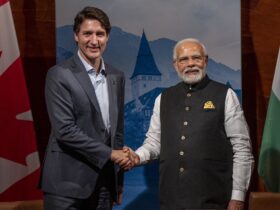The United States and Canada jointly imposed sanctions on Tuesday, targeting the Samidoun Palestinian Prisoner Solidarity Network, an organization accused of fundraising for the Popular Front for the Liberation of Palestine (PFLP), a designated terrorist group. These sanctions arrive amid rising tensions and growing violence across the Middle East, where multiple conflicts have escalated, drawing global attention to the region.
Sanctions and Accusations
The U.S. Treasury Department, along with the Canadian government, announced that Samidoun, a charity operating in Gaza and the West Bank, has been providing financial support to PFLP, which has been on the U.S. list of foreign terrorist organizations since 1997. Khaled Barakat, a senior figure in the group, was also specifically named and sanctioned.
According to Bradley T. Smith, the U.S. Acting Undersecretary of the Treasury for Terrorism and Financial Intelligence, “Organizations like Samidoun masquerade as charitable actors providing humanitarian support, but in reality, they divert funds to support terrorist groups.” The sanctions are designed to block the group’s access to the U.S. and Canadian financial systems and bar citizens of both countries from dealing with them.
Heightened Conflict in Gaza and Lebanon
As these sanctions were being announced, the situation in the Middle East continued to spiral. Israeli airstrikes in Gaza killed at least 15 people overnight, including six children and two women, according to Palestinian medical officials. Strikes targeted residential areas in southern Gaza, including the towns of Beni Suhaila and Fakhari. In one particularly devastating strike, 10 members of the same family, including three children, were killed. Hospitals in the region reported the bodies, with further casualties continuing to flood in.
The Israeli military, which rarely comments on specific strikes, maintains that it aims to avoid civilian casualties, blaming Hamas for using civilian areas as shields. However, Palestinian health authorities say that women and children have made up more than half of the fatalities in Gaza since Israel launched its offensive, which has claimed over 42,000 lives in the region. The conflict has displaced approximately 90% of Gaza’s population, totaling 2.3 million people.
Hezbollah’s Growing Role and Threats
Meanwhile, Hezbollah, the Lebanese militant group, has been increasingly involved in the conflict. Cross-border exchanges of fire between Hezbollah and Israeli forces have become a near-daily occurrence. In a televised address on Tuesday, Hezbollah’s acting leader, Sheikh Naim Kassem, vowed to continue targeting Israeli cities like Haifa and Tel Aviv, warning that over 2 million Israelis would be at risk if the conflict continues.
Kassem’s speech marked his third public appearance since Hezbollah leader Hassan Nasrallah was killed in an Israeli airstrike on September 27. Kassem sought to rally Hezbollah supporters, calling on them to remain steadfast as Israeli air and ground campaigns intensify. He emphasized that Hezbollah’s goal is to “hurt the enemy” and suggested that a ceasefire is possible but only on their terms, denying that they seek a ceasefire out of weakness.
The Lebanese militant group has been closely aligning its actions with the broader Palestinian struggle, underscoring the interconnectedness of the conflicts in Gaza, Lebanon, and Israel. This linkage has added to the complexity of the situation, making the possibility of a resolution or ceasefire appear increasingly distant.
U.S. Military Support for Israel
As the violence intensifies, the United States has increased its military support for Israel. A team of U.S. troops operating a missile defense system, known as Terminal High-Altitude Area Defense (THAAD), arrived in Israel this week to defend against ballistic missile threats, primarily from Iran. The U.S. military has said that additional personnel and equipment will continue to arrive in Israel over the coming days to ensure the defense system is fully operational.
Iran has already launched two ballistic missile attacks on Israel since the escalation began, raising fears that the conflict could widen further. The Pentagon has warned that American troops could also be in danger if Iran continues its aggression, marking another volatile dimension to the conflict.
Humanitarian Crisis in Gaza and Lebanon
The humanitarian situation in Gaza is becoming more desperate by the day. Thousands of civilians are trapped under constant bombardment, with aid organizations struggling to deliver critical supplies. Despite these challenges, the UN health agency launched a second phase of its polio vaccination campaign in central Gaza on Monday, managing to vaccinate over 92,000 children under the age of 10. However, with nearly 600,000 children in need across Gaza, the effort is still facing significant obstacles due to the ongoing fighting.
The situation in Lebanon is equally dire, with hundreds of thousands of people displaced as a result of Israeli airstrikes targeting Hezbollah strongholds. The UN has reported that over 400,000 children have been displaced in Lebanon alone in the past three weeks.
Iran’s Ongoing Threats
At a funeral for Iranian Revolutionary Guard General Abbas Nilforushan, who was killed alongside Hezbollah leader Hassan Nasrallah, Iranian military leaders continued to issue direct threats against Israel. General Ali Fadavi, a deputy commander of the Revolutionary Guard, told mourners that “if we will, we can obliterate all the Zionists,” underscoring the deeply entrenched animosity between Iran and Israel. The Guard’s leadership, including Quds Force commander General Esmail Qaani, was present at the funeral, further stoking fears of Iran’s involvement escalating into direct military engagement with Israel.
Looking Ahead
The imposition of sanctions on the Samidoun network by the U.S. and Canada reflects the broader international concern over the escalating violence in the Middle East. As Israel continues its military campaigns in Gaza and Lebanon, and as Hezbollah and Iran ramp up their retaliatory threats, the situation remains precarious. Efforts for de-escalation and ceasefire seem distant, as key players in the conflict—both state and non-state actors—continue to pursue aggressive military actions.
With the humanitarian crisis worsening, and political and military alliances hardening, the Middle East finds itself in one of the most volatile periods in recent memory, with no clear resolution in sight. The involvement of global powers, both militarily and diplomatically, continues to shape the conflict, with far-reaching implications for regional and international stability.












Leave a Reply